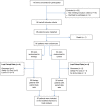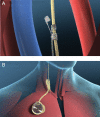Chronic vagal stimulation for the treatment of low ejection fraction heart failure: results of the NEural Cardiac TherApy foR Heart Failure (NECTAR-HF) randomized controlled trial
- PMID: 25176942
- PMCID: PMC4328197
- DOI: 10.1093/eurheartj/ehu345
Chronic vagal stimulation for the treatment of low ejection fraction heart failure: results of the NEural Cardiac TherApy foR Heart Failure (NECTAR-HF) randomized controlled trial
Abstract
Aim: The neural cardiac therapy for heart failure (NECTAR-HF) was a randomized sham-controlled trial designed to evaluate whether a single dose of vagal nerve stimulation (VNS) would attenuate cardiac remodelling, improve cardiac function and increase exercise capacity in symptomatic heart failure patients with severe left ventricular (LV) systolic dysfunction despite guideline recommended medical therapy.
Methods: Patients were randomized in a 2 : 1 ratio to receive therapy (VNS ON) or control (VNS OFF) for a 6-month period. The primary endpoint was the change in LV end systolic diameter (LVESD) at 6 months for control vs. therapy, with secondary endpoints of other echocardiography measurements, exercise capacity, quality-of-life assessments, 24-h Holter, and circulating biomarkers.
Results: Of the 96 implanted patients, 87 had paired datasets for the primary endpoint. Change in LVESD from baseline to 6 months was -0.04 ± 0.25 cm in the therapy group compared with -0.08 ± 0.32 cm in the control group (P = 0.60). Additional echocardiographic parameters of LV end diastolic dimension, LV end systolic volume, left ventricular end diastolic volume, LV ejection fraction, peak V02, and N-terminal pro-hormone brain natriuretic peptide failed to show superiority compared to the control group. However, there were statistically significant improvements in quality of life for the Minnesota Living with Heart Failure Questionnaire (P = 0.049), New York Heart Association class (P = 0.032), and the SF-36 Physical Component (P = 0.016) in the therapy group.
Conclusion: Vagal nerve stimulation as delivered in the NECTAR-HF trial failed to demonstrate a significant effect on primary and secondary endpoint measures of cardiac remodelling and functional capacity in symptomatic heart failure patients, but quality-of-life measures showed significant improvement.
Keywords: Autonomic nervous system; Heart failure; Vagal stimulation.
© The Author 2014. Published by Oxford University Press on behalf of the European Society of Cardiology.
Figures
Comment in
-
Vagal nerve stimulation in heart failure.Eur Heart J. 2015 Feb 14;36(7):404-6. doi: 10.1093/eurheartj/ehu363. Epub 2014 Aug 31. Eur Heart J. 2015. PMID: 25176941 No abstract available.
-
Heart failure: Vagal stimulation in patients with HF.Nat Rev Cardiol. 2014 Nov;11(11):621. doi: 10.1038/nrcardio.2014.150. Epub 2014 Sep 16. Nat Rev Cardiol. 2014. PMID: 25223444 No abstract available.
References
-
- Mortara A, La Rovere MT, Pinna GD, Prpa A, Maestri R, Febo O, et al. Arterial baroreflex modulation of heart rate in chronic heart failure: clinical and hemodynamic correlates and prognostic implications. Circulation. 1997;96:3450–3458. - PubMed
-
- Ponikowski P, Anker SD, Chua TP, Szelemej R, Piepoli M, Adamopoulos S, et al. Depressed heart rate variability as an independent predictor of death in chronic congestive heart failure secondary to ischemic or idiopathic dilated cardiomyopathy. Am J Cardiol. 1997;79:1645–1650. - PubMed
-
- Li M, Zheng C, Sato T, Kawada T, Sugimachi M, Sunagawa K. Vagal nerve stimulation markedly improves long-term survival after chronic heart failure in rats. Circulation. 2004;109:120–124. - PubMed
-
- Schwartz PJ, De Ferrari GM, Sanzo A, Landolina M, Rordorf R, Raineri C, et al. Long term vagal stimulation in patients with advanced heart failure: first experience in man. Eur J Heart Failure. 2008;10:884–891. - PubMed
Publication types
MeSH terms
LinkOut - more resources
Full Text Sources
Other Literature Sources
Medical
Research Materials
Miscellaneous




